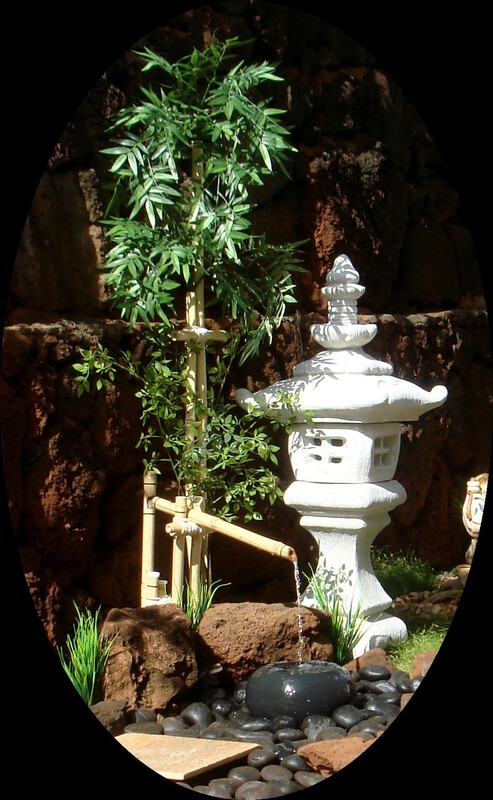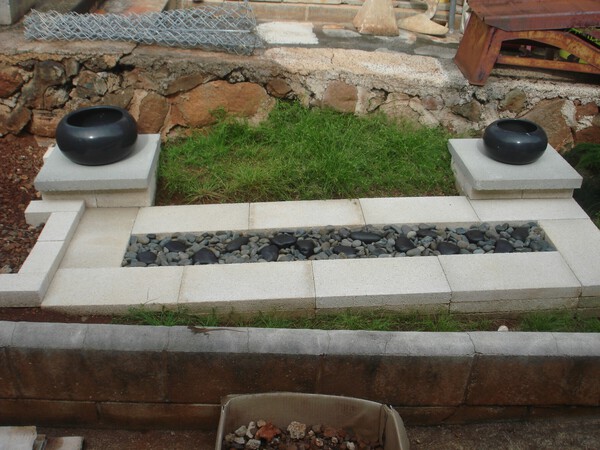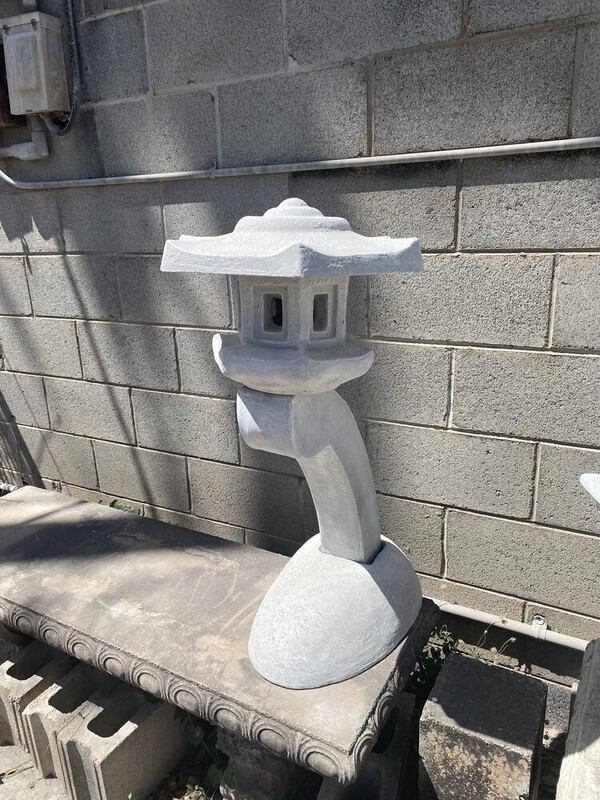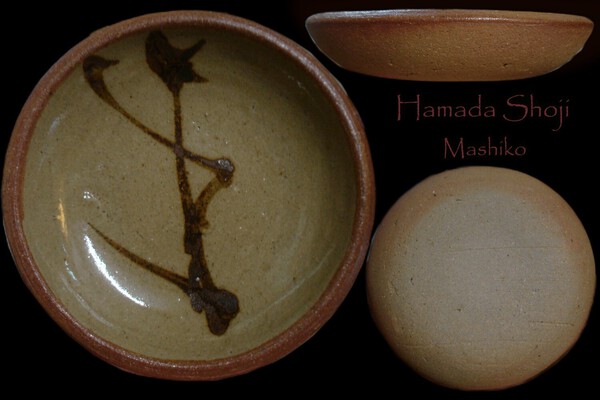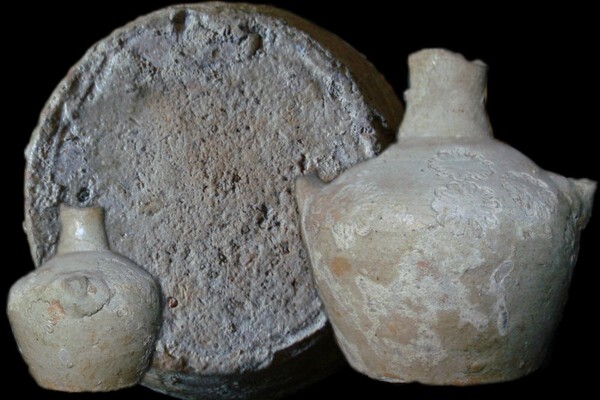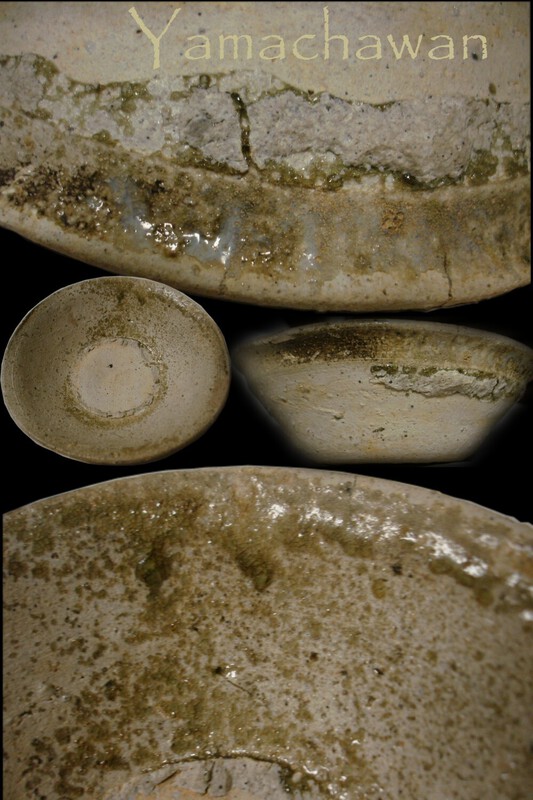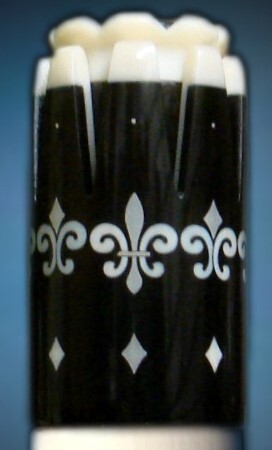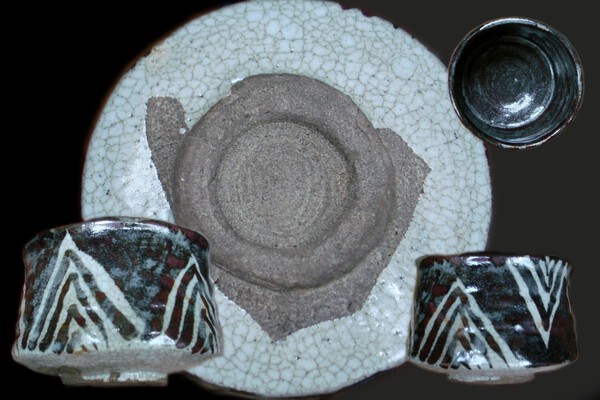-
Posts
317 -
Joined
-
Last visited
-
Days Won
6
Content Type
Profiles
Forums
Events
Store
Downloads
Gallery
Status Updates posted by ken kata
-
Japanese GARDEN STONE LANTERNS
I love Japanese Stone Lanterns.
Lanterns are one of my favorite Japanese Garden items .
Of course, there "Authentic/Old" and, "Authentic New", and, the type can afford nd find locally in Honolulu Hawaii.
I found some at KISO STORE, in Waipahu, Hawaii.
They have been in business for decades.
They have a connection to a local guy that makes concrete Japanese type Lanterns.
I am so thankful and fortunate to have them here.
If not for them, I would have to buy and pay for shipping to Hawaii.
So far, I have 2 of their Tachigata doro ( Daitsuki ) and, another that I do not know the name / type of lantern it is..
Here are a few videos that are found from YOU TUBE , about JAPNESE STONE LANTERNS :
1) (JGTV) Do you know how many types of stone lanterns there are?
2) How to choose a stone lanterns in a Japanese garden.
3) Lantern Store
4) Lantern Storage Yard
There are my two types of Concrete Lanterns I bought from KISO STORE :
-
Newly renovated front door Garden section. I wanted to do a "Make Over" of my mother's yard.
" Before and After" photos of the front door side garden.
I was trying to make a Japanese style Garden.. As always, I am not fortunate enough to be able to spend and/or obtain
authentic Japanese Stoneware ( Lanterns / Tsukubai , rocks and stepping stones ) and plants.
It's my fault for being incompetent.
I depend on Lowe's, Home Depot, Amazon, e bay, and, KISO STORE in Waipahu, Hawaii.

-
Niwa-shi - Stone Pathways
Nobedan -
One of my favorite types of Stone Pathways are Nobedans.
I am still researching the name, the types / categories,
and/or styles of these combinations of slender rectangular cut stones and flagstones/rover stones/rocks.
And, the applicable "rules" , do's and don'ts , suggestions of design and history of Nobedans.
I keep searching the Internet and YOU TUBE for information and knowledge.
I am hoping to find a comprehensive and well made site on Nobedans to learn more about them.
Below is a photo of a " Nobedan inspired " setting of Concrete Tile Caps and River Rocks from LOWE'S.

No money, no Nobedam... LOL

-
I want to be a Niwa-shi

I've been fixing up the outside yard of my Mother's house for about a year.
I m trying to make " Japanese Style" Gardens, in/on the little areas , and, where ever there is
spaces/places that needs "improvement" / " Attention"..
I want to get a "KEI
I have been trying to learn as much as I can about Japanese Gardens and trying to learn what
" Niwa-shi's " learn / know...
One thing is for certain..
Unless you have a lots of money, you can't make a nice " Authentic " Japanese style Garden anywhere in the world.
It's hard to find authentic Japanese Stone works ( Lanterns , Chozu baichi / Tsukubai ( Water Basin ), etc.....
And, If you live in Japan, you will need a lot of money to make a Japanese Garden.
Japan has all the items you would need, and, they are all aged ( Koko / Wabi Sabi " ) and " authentic".
I've been looking around trying to buy a Stone Lantern.
The shipping alone is $$$$.
I thought I'd better look of someone in Hawaii that has one to sell.
I was looking for a Renkei Lantern.
I can' seem to find articles or any websites that gives information on these "cantilever" type Lanterns.
I saw this " Cement/Concrete " Renkei Style Lantern at KISO STORE, a place that sells Garden and Yard Masonry and Rock/landscape Items in Waipahu, Hawaii. Very basic. I'm not sure how tall it is.
I will be inquiring soon.
-
Japanese Ceramics - Soma
I'm sure you guys all know Soma ware.
If you see their tea cup and dish wares, you will know immediately.
This is a Tea Bowl that I bought a few years ago.
A bit different from what Soma is noted for..
SOMA YAKI link :
https://www.jcccw.org/nikkei-news/2020/6/11/soma-yaki-pottery-loved-by-Japanese-americans
From the link above :
" On March of 2011, an unprecedented disaster struck the Soma-yaki potters.
The tsunami that ensued from the magunitude-9 Great East Japan Earthquake damaged the Fukushima Daiichi Nuclear Power Plant, which was located only a few miles from Namie, and caused one of the worst meltdowns in history.
The town’s entire population of 21,000 was evacuated. As of May 2020, most of Namie, including Obori was still heavily contaminated with radiation, and access remains restricted. Before the earthquake, there were about 20-25 factories.
Unfortunately, due to the aging of potters, and financial issues in addition to the tremendous difficulties caused by the evacuation, some of them went out of business. The other half moved away from the region and got to rebuild kilns.
Today, they create tableware, decor and jewelries with new fashionable designs as well as the traditional double-wall crackleware with an image of a horse, appreciating that they can make Soma-yaki again. "
-
Japanese Ceramics -Sumidagawa
I bought this pretty vase/Flask , and, I have only seen one other like it for sale.
I also got two other rSumidagawa vases.
Those have the small men or children figurines on the other surfaces.
The Crab Theme ones are the hardest to find.
Not to be confused with the Rakuzan , Shigaraki or Suigetsu ceramic Crabs.
I will post my ceramic "Crab" collection soon.
-
Nihonto - Wakizashi in Shirasaya
I got this Wakizashi awhile back. I still don't know what it is.
I got several blades that I never posted to inquire about.
Most of my blades are the " low cost" , and, not worth posting , and,
wasting the other member's time..
I just look at my swords when I feel like looking.
I have been fortunate to have 3 rooms that I can use to make my small
Japanese Museum with my collectables .
I think I got over 500 pieces of Japanese tea bowls and other ceramic pieces.
I surround myself in my collection.

-
-
-
Kitaoji Rosanjin - Joan Mirviss Lectures
I enjoy Joan Mirviss' lecture on Japanese Ceramics.
She just up-loaded two more video Lectures on Kitaoji Rosanjin and other passed Japanese Potters.
-
The Unknown Craftsman -Shoji Hamada, Mashiko, Mingei and Karatsu
Another love of mine is Shoji Hamada and the Hamada Family, and, Mashiko ware and the Mingei Movement.
After my love for Seto/Mino wares and Karatsu ceramics, I enjoy Mashiko and the Hamada Family Tradition.
I have always felt the connection between Karatsu ware and Mashiko ware.
I love the brush work of the Potters.
e-shino, Oribe, e-Karatsu all have that Ink Brush Paintings that I love.
It started with Chinese ink Brush Paintings on scrolls.
From realistic to impressionistic, and, then, catching the love of the Japanese people.
Also, from Korea, in their " Buncheong " which is short for " Bunchong Punch'ǒng Sagi " .
" Gray stoneware body coated with a white slip, and decorative designs are painted on using an iron pigment., under a clear glaze with greenish tint. "
My Shoji Hamada Mizusashi ( Water Jar )
-
Phil Rogers 1951 - 2020
This December 22nd, will be one year since the passing of Phil Rogers..
One of the great potters that brought so much to the modern world of pottery.
In the sense , he brought us closer in to the world of Japanese ceramics and pottery.
Since Phil's passing, I notice that most of his videos on Japanese pottery and his visits to the Mashiko shops and the works and world of Shoji Hamada, the Hamada Family, and, the Mingei Movement were removed from the internet.
I loved watching those videos over and over.
Thank You Phil Rogers..
You will be missed....
I did have a chance to speak to Phil, and, I bought one of Shoji Hamada's
H133 Pressed dishes..
" These pressed dishes, influenced by English slip ware
hump molded dishes, were a form that Hamada produced
in various glazes and patterns.
This example carries the broken straw motif in iron brush pattern.
A very typical and immediately recognizable work by Hamada, and,
very suitable as a first Hamada Shoji in a Collection "
- PHIL ROGERS
I received this dish from Phil Rogers about two years ago..Dish is 5 inches across.
Shoji Hamada's "Broken Sugarcane" Brush work is well recognized in the Mashiko/Mingei world.
-
Japanese Tea Bowl - Mt. Fuji Tea Bowl Collection
I use to buy lots of Mt. Fuji theme Tea Bowls.
This is an old photo.
I made a larger shelves , but, I need to clear up all the
plates and other tea bowls on the floor in my Tea Bowl Room.
I got so much ceramic/pottery stuff, , I stopped buying ceramics.
Then, I can take nice photos of my display rooms.
-
Japanese Armor Room - High Fidelity
I tried putting my A-9 Towers in my Armor Room as a second Audio System.
NOBSOUND TUBE Pre Amp with replicated Marantz Model 7 internals. McIntosh Amplifier.
 Martin Logan XL-15's in the background. They sound "Plush", but, still sounds good.
Martin Logan XL-15's in the background. They sound "Plush", but, still sounds good.
I got so much Japanese stuff in my Rooms. This is my Armor and Oribe Ceramics room. Now, the floor is full of Mizusashi Water Jars...

-
Japanese Ceramics - Natural Glazed from Excavations
I have read that there are many Natural Glazed items found at the various excavation sites throughout Japan.
I was curious to see what these early ceramic pieces look like.
Many can be bought on the internet, and, the cost seem relatively low, but, it's probably because there are so abundant.
Another reason, might be, that they are not "real" artifacts.. ???
I have one medium size jar, one that seems to be an ewer, and, 4 Yamachawans, ( Mountain Tea Bowls ).. only 3 are shown.
-
Japanese Ceramics - Flight from Seto Mountain
Of all the Japanese ceramic pieces I like/buy, I love Seto/Mino .
I try to read and watch everything about the history and items made, especially the early periods of development.
There are so many aspects and details, and, to find and gather all the facts to establish what really did happen and how things came to be.
One is the "MOMOYAMA ' period Tea Bowls that look similar the Edo period Ao Oribe Tea Bowls.
I believe many ceramic enthusiast are fascinated by these "Less than perfect" bowls, and, like Koto Blades, no one seems to know how they were made or came to be what they are/look like.
These early bowls have several " factors " that can have their own discussions in it's self.
One period that I want to learn more from is "What exactly happen and what changes, or, exchanges ( between the Seto and Mino Potters) took place during that time.
It is :
" Flight from Seto Mountain " and "Summons to the Kilns "
" During the Warring States period many potters fled Seto for Mino in order to escape the war, as the term "Seto-yama-risan (Flight from Seto mountain)" suggests, where they received protection under the policies of Oda Nobunaga. Bowls and decorative plates with the distinctive style of Seto ware, Oribe, Shino and Ki-seto have been discovered in the remains of Mino's kilns from this period.
Upon entering the Edo period, the potters who had left Seto as part of the "Seto-yama-risan" returned to Seto region once again. The Owari branch of the Tokugawa family summoned the potters back to Seto as part of the so-called "Kamadoya-yobimodoshi (Summons to the kilns)", and the Seto area flourished once more. "
I forgot what book or website I got this Quote from...

Added : This is the website for that paragraph above :
https://Japanese-ceramics.com/seto-ware/
-
Stuff I Made - Malachite, Amboyna Burl, Pink Ivory
Cue collector's cues, that I was fortunate to make their "Joint Protectors " . Crown Cue Caps.
" It's easier to be the first guy, than the second guy trying to copy the first guy " Alton Takata - Cue Caps

Malachite " WINGS II " , by great CNC Cuemaker Thomas Wayne.
Silver Wire inlaying.
8 Point Ebony/ Amboyna Burl Cue by the Hall of Fame cuemaker Bill Schick. Bill uses a Pantograph for his inlay work. No CNC involved.
Awesome/Pretty Cue - African Pink Ivory Wood cue by Keith Josey. I read, at one time, only Kings could posses this wood. Penalty for others was death.

-
Semi Precious Stones - Sugitite , Light Denum Lapis, Charoite
Fleur de lis , Sugilite and Light Blue/Denim Lapis
Sugilite was first discovered in 1944 by a Japanese petrologist named Ken-ichi Sugi, which is where it gets its unique name.
Sugilite and Light Blue Lapis
Charoite and Light Blue/Denim Lapis by the great Tad Kohara
" I don't make the Cues,
I just help make the Cues look better" - Alton Takata

-
Stuff I Make - CNC Inlaying - Pocket Billiard Pool Cues - Exotic Stones
I wanted to start doing inlays in my " CUE CAPS ". Cue CAPS is a name
I made up in the early/mid 1990's.
Cue Caps are, what the billiard industry call " Joint Protectors ".
Joint Protectors screw on and over the exposed threaded screw and covers the internally threaded hole in the upper "Shaft" section on the two piece billiard Pool cue.
I bought a bench Top 4 Axis CNC Milling Machine and the CAD/ CAM
Post Processing Software and started to learn how to do custom shape inlays to match high $$ Collectable, "Functional Art" Custom Pocket Billiard Pool Cues.
I made some and showed them, and, collectors started to contact me and asked me if I could make a Crown Cue Cap Set to match their cues.
I have to look at the Cue's design and materials and create the drawings/tool paths and bring all that to a "Machine Language" and then, in many machine processes, I create my Cue Caps.
I got more Japanese Ceramic post that I wanted to post, but, I thought I'd take a break and show you these Cue Caps.
I will start showing you my favorite Caps that I made for collectors, these with Semi precious stones.. Today, Turquoise :
-
Japanese Tea Bowl - Mino Tea Bowl Damage
I had to accept/keep the broken Mino tea bowl because the cost for the return shipping and insurance would be too high and I would not be compensated for that.
But, if the returned box with the broken tea bowl was lost in the shipping, I would loss again.
So, I just will have to take the lost.
The seller told me that it was the shipper's fault, and, PayPal would not honor the Buyer protection if I had "Refused acceptance" even if I tell the carrier guy the box is smashed and can heat the pieces rattling inside.
Plus, the seller's wife would lose out too. And, she had nothing to do with the mailing.
So, loser all the way. LOL

This green on this tea bowl , and, the other Green tea bowl with the Plovers, have a tinge of blue in the greens.
The other green Mino bowls I bought form the seller had the greens as seen on most /other AO Oribe items..
I have seem books refer "AO Oribe" as " BLUE Oribe".
I started gluing the cracked pieces together and will start adding in the gold filling in the cracks.
I am not mad at the seller.
Please do not spread this story around.
The seller has a wife and maybe a family.
This is just for our info..
One of the reasons I do not want to post this in the main NMB
sections..

-
Japanese Tea Bowl - 400 Year Old Conclusion
After reviewing all " confidence " the seller put in the Tea Bowl listings, I still do not think these are " 400 year old Mino " bowls.
For me, I bought them because these potters/makers made bowls that I like.
Actually, the seller had a nice selections of the kind of tea bowls I wanted at the time, and, under 150 dollars.
Small price to pay for the maker's share and the seller's profit.
That is why I am not worried about this being real " 400 year old bowls. "
One thing happen, and, happen to this one bowl I bought from him..
The box was flimsy and the bowl was not well packed for a 400 year old tea bowl.
Oh well.... LOL
Ao-Oribe Chawan of Early Edo Period
" Distorted 'shoe' shaped (Kutsugata) tea bowl with a rounded brim, made of light, coarse, unrefined Mino clay.
The expertly thrown body was trimmed with a potter's knife in its lower part and around the foot ring.
This bowl was covered with a green copper oxide glaze.
On one side a window left unglazed and covered with a thin transparent ash glaze under which hoshigaki (persimmons hanging from a roof in winter for drying) and some square devices to scare birds off (this is the most popular interpretation) were painted in iron oxide.
The foot ring is in a shape frequently found on shards excavated at the Entogawa-kiln in Mino, active during the first quarter of the 17th century. "
-
Japanese TEA BOWLS - TL Testing of the Mino Tea Bowls
TL testing would have sacrificed a few of the seller's tea bowls, and,
several hundred dollars. Yet, the conclusions/findings was pointing toward 400 years old ( + or - ).
I bought about 9 tea bowls from the seller, two under a 100 dollars and several about 150 dollars each. A couple about 240 each.
Obviously, the pricing for these 400 year old Mino tea bowls seem to contradict all the "confidence" presented by the seller..
The cost seem to be O.K. with me, as, even though I'm sure
these tea bowls are not 400 years old,
I like the potters/makers style and designs.
Also, the prices for the actual tea bowls were lower than the sold pricing I paid, as, the seller added " his/her " percentage to make a profit. They have to make a living too.
The seller's wife is Japanese (?), and, brings back teas bowls when she visits/travels back to Japan and back. I think it was via a P.M. to me..
They / she must know the source of these tea bowls, as, I have seen other sellers that have similar tea bowls. One even bought form this seller.
This " 1620 " bowl was one of the more "expensive" tea bowls I bought from the seller .
Here is the seller's description of the 400 year old tea bowl :
Nezumi-Shino Tea Bowl - Early Edo Period (about 1620)Little deformed cylinder (hazutsu) shaped, in the style of shino ware - the bowl shows finger marks from throwing; foot ring and bottom have been cut with a potters knife.
Typical for a Nezumi-Shino shino bowl, the light, unrefined Mino clay has been covered with an iron bearing engobe - with the exception of the bottom area.
A geometric decoration of triangles on the wall has been incised into the engobe, over which the typical feldspatic shino glaze has been applied.
The foot ring has a rather regular shape, with comb marks frequently seen on bowls from Motoyashiki kiln.
-
The information in the CHUO EXPRESS Excavation page was about Jomon Period items.
I was hoping I could find more information/websites about any newer excavations that might be the bowls the seller has.
I don't have enough/any Japanese knowledge on key words or phrases to use for the internet searches for newer Mino Bowl excavations.
The ending part of the seller's bowl descriptions had this :
" All four pieces I had TL-tested (Cost about $ 400 per piece) have confirmed an age about 400 yrs =/- 20%. "
I think he explained they were random from the batch of bowls he had..
This is from one of many TL Testing websites on the internet:
Accuracy of TL testing / dating
Generally speaking, when a sample is drilled and there is no information available about the burial environment, one may expect +/- 25% uncertainty, and this is more than adequate for authentication where the question is whether the piece was fired in antiquity or recently. The latest computer technology supports and completes analysis.Link :
-
Japanese Tea Bowl - MINO
Note: This is not a rant or complaint about the seller of these
" excavated" tea bowls " .
I am explaining the several intriguing/fascinating explanations that accompany the selling
of his/her tea bowls.
I do have several more tea bowls bought form the seller.
I will post them later in this series of postings about my experience.
So, first off, I want to establish the seller's beautifully stated, some what romanticized descriptions of each tea bowl.
I love his (or, who ever stated that ) description of each tea bowl.
It somehow, establishes the seller has knowledge of Mino tea bowls.
Secondly, Here is a statement that accompanies the description from the sellers postings :
" Mino ceramics were produced for the Kyoto market.
About 1630/40, a change of fashion took place, resulting in an overproduction at the kilns.
The merchandize was still warehoused at the kilns, but the Kyoto whole sellers did not buy anymore.
This is also evidenced by a number of full warehouses excavated in Kyoto.
Over the years the kilns were covered by leaves and humus.
Before the Tokyo Olympics an new highway was built trough the region (the Chuo Expressway), during the construction unknown kilns were unearthed but not scientifically recorded, because of time pressure.
On the construction free weekends people (mostly farmers living nearby) went 'treasure hunting' and found truck loads of tea bowls mizusashi and other tea ceramics.
Since about 1990 , these pieces appear in the market in Japan, as young people have little interest in tea ceremony or collecting anymore.
Of course there are broken pieces, but many are unharmed and were well protected by the soft earth of the woods; after rinsing the them with water, they look like new ? even though many have discoloration from black soil at the unglazed areas.
So, the first part, the seller, who has "knowledge" of Mino tea bowls, has a explanation of how he acquired these 400 year old Mino tea bowls , the CHUO EXPERSSWAY EXCAVATION.
I was searching the internet for information on the CHUO EXPRESSWAY EXCAVATIONS.
There was only one article I found, but, it was during the 70's and 80's. Not in the 1990's.
It also seems, that there were older ceramic pieces found. no mention of Edo period ceramics, unless, there was another "Excavation" later?
Here is a part of the CHUO EXPRESSWAY article :
" It may sound odd to have a museum accessible from an expressway rest area, but there is a story behind it.
During the construction of the Chuo Expressway in the late 1970s/early 1980s, planners realized the expressway would run through the Shakado area (named for a local temple) known to contain historical ruins.
When the road builders started digging the road bed, the ruins were found to be quite extensive, with layers of important artifacts dating from 1,000 years ago to 20,000 years ago.
It was decided to halt the road construction while the entire area was thoroughly excavated.
To complete the excavation as quickly as possible, an army of diggers–more than 20,000 people–were employed, including professional archaeologists, local farmers and their families, university students, and anyone willing to help out.
The dig lasted from February 1980 to November 1981.
Only after the excavation was completed was the expressway construction continued. "
Here is the link:
https://jigsaw-Japan.com/2019/02/16/shakado-museum-of-jomon-culture-really-digging-back-in-time/
-
Japanese TEA BOWL - MINO
Another tea bowl I bought from the seller that has 400 year old "Oribe" style/type tea bowls.
Note : Again, I do not think these bowls are 400 years old.
I bought them because I like them.
This is not a rant about the seller.
It is more of the interesting accounts that occurred
during the time I was buying these Mino tea bowls.
The seller's description :
Kuro-Oribe Chawan of Early Edo Period
" Slightly distorted cylinder shaped (hanzutsu) tea bowl with a rounded brim, made of light, coarse, unrefined Mino clay.The expertly thrown body was trimmed with a potter's knife in its lower part and around the foot ring.
In the style of Seto -Kuro bowls the this bowl was covered with a glossy, light brown glaze.
On one side a window was left unglazed and decorated with plants and grass in iron oxide under a clear ash glaze.
The low foot ring and the bowl's cylindrical shape resembles a Seto-Kuro bowl.
Next to the foot ring is an incised potters mark (kamajirushi) in form of a T.
This mark is commonly affiliated with the Kyoto trader Shimbei and was frequently found on early 17th century (arround1620) pots of the Entogawa-kiln in Mino.
The bowl is well balanced. "Next Post: The Chuo Express Excavations "




